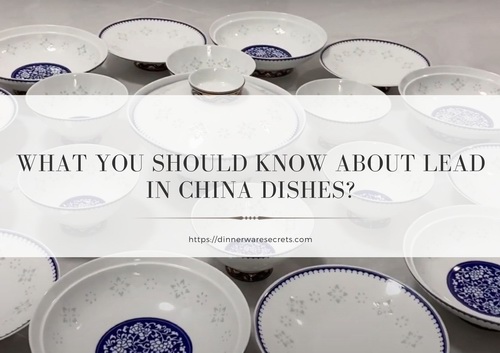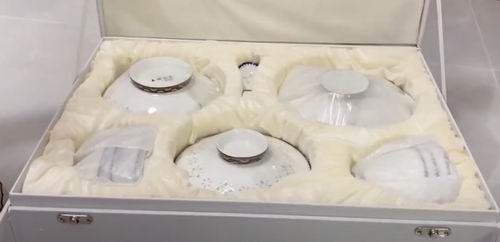
Do you still have to stay at home? Now, you may focus on your household activity. Hanging out with your friends is not always appropriate. Why don’t you arrange a small, family gathering? It might be charming and intimate. Sophisticated, antique dinnerware makes it pleasant and refined. Food safety is primary. What you should know about lead in china dishes? Before buying a new table or tea set, eliminate potential risks and hazards. Check chemical content of the product. No toxic elements like cadmium or lead are to be available inside and on the surface. How do you find information on the subject? Keep reading the article and gain insight.
Do China Dishes Have Lead?
Unfortunately, restrictions on social distancing are still actual this year. They commonly concern traveling practices, libraries and museums. Restaurant business may anticipate restriction ease soon. With certain limits, indoor dining and gatherings are possible.
What about celebration of a formal event? Anniversary of your family member or your marriage day is a special occasion. Dining at home, you might want to use your best antique china dishes. Quite naturally, you treasure your family heirloom. You wash them by hand, using mild, natural detergents.
Safety requirements are paramount. Is unglazed pottery food safe? Commonly, bone china carries no threat. It features:
- Subtle transparency.
- Light or milky white color.
- Smooth, easy to wash surface.
- Incredible hardness.
- Beneficial, non-toxic content.
Bone ash in the china composition is beneficial for human health. It makes your dinnerware stronger and brighter. Decorations and glaze might be hazardous. Plain white dishes are non-toxic. Decorations on the outside surface that is atop the glaze could be poisoning.

What Are the Safest Dishes to Eat off of?
Any kind of paint on the bowl or mug surface is undesirable. It would be a sign of poor quality or breakdown in the technological process. High heat is beneficial. Manufacturers and artisans apply it to bond glaze to the surface. It makes your dishes durable, stain and water-resistant.
Type of your dinnerware also matters. China vs porcelain vs ceramic is thinner. It’s more delicate and refined. Meanwhile, it’s strong and long-lasting. It features a tiny layer of glaze that protects it from scratching and chipping. Let’s estimate the key differences in these basic materials.
| Dinnerware Type | Porcelain | Bone China | Ceramic |
|---|---|---|---|
| Composition | kaolin, silica, feldspar | bone ash, kaolinite, feldspathic material | clay |
| Vitrification Process | two-firing | single-firing | bisque firing |
| Firing Temperature, °F | 2,200-2,600 | 2,100-2,280 | 1900-2000 |
| Finish | hard | glazed | porous |
| Weaknesses | brittle | thin-walled, lightweight | fragile, vulnerable to damages |
Most dinnerware types contain kaolin clay mineral. It’s white, soft and earthy. Meanwhile, bone china has high (25-40%) bone ash content. Calcium phosphate in its composition makes ancient dinnerware brilliant-white. It improves its physical and mechanical strength.
Why Do Some Glazes Have Cadmium in Them?
Calcium phosphate in bone china composition is non-toxic. Being an essential part of tooth enamel and bones of living organisms, it’s beneficial. White solid is biocompatible. It has nutritious value while people take it as calcium supplements.
China dinnerware itself is completely healthy and eco-friendly. Knowing porcelain dinnerware pros and cons, you would prefer plain white items. They might be perfectly safe. FDA has approved strict food safety standards since the 1970s. Decorated china products pass complicated, 3-5 times firing process.
Pay attention to the patterns and decorations. Bold-colored coffee mugs or decorated teacups could contain toxic chemicals. Researchers from Assam University, India have found them. It’s possible if your dinnerware is:
- ancient;
- coming from abroad;
- traditional;
- highly-decorated;
- hand-crafted.
Small job shops and talented artisans create their sophisticated masterpieces abroad. They add traditional details. Floral patterns and golden rims look beautiful. It makes your precious collectibles unique. However, ancient and foreign manufacturers might compromise technological requirements. Dinnerware of this kind might be harmful.
Is Lead in Dishes Dangerous?
Traditional terra cotta dishware may contain lead. A layer of transparent glaze on the pot surface is non-persistent. It wears off very soon. If your plate or bowl has signs of fading, it’s sad. However, you lose not only the consumption value of your beautiful dinnerware.
Its surface leaches harmful chemicals to your food. It reacts with acidic liquids like juices and sauces. These toxic substances accumulate in your body. They cause lead poisoning, targeting brain and lungs. Possible adverse effects include:
- headaches;
- anemia;
- constipation;
- abdominal pain;
- vomiting and nausea.
In case of permanent effect, it may cause intellectual disability. Brain, lung or kidney cancer is possible. Cadmium uptake is also harmful. Some foodstuffs, like mushrooms and mussels, contain this element in small quantities. Tobacco smoke or hazardous waste from factories transport cadmium to your lungs. It would destroy your immune or central nervous system.

What Brands of Dinnerware Are Lead-Free?
Concentrations matter. Lead-safe tableware contains permissible level of this chemical element. Both FDA and California authorities regulate it. Labeling of all dinnerware products is not valid. But Proposition 65 standards are in force. They require manufacturers to provide warnings about potential hazards.
I would recommend you avoid buying the products you like, if:
- their package contains a yellow triangle;
- a warning message about lead exposure is available;
- decorations on the tableware surface are raised or rough;
- they are available in a foreign country;
- small local retail store offers the sets or separate items without packaging.
Nowadays, only and lead-free dinnerware made in the USA is available. If it sells legally in our country, it’s healthy. Certified organizations test all products for lead content. Ask your authorities for the list of reputable manufacturers. It includes Corelle, Pyrex and Visions for sure.
You can test your dinnerware by yourself. Rub the swab on the decoration surface. If it turns pink, it’s dangerous! Meanwhile, I would recommend you avoid buying tableware while traveling. Hand-crafted items, selling in a small, retail outlet might be not safe enough. They could compromise firing and vitrification technology requirements.
Video Review: What You Should Know about Lead in China Dishes?
Bottom Line
Are you going to buy a new refined china set? It’s a pleasant task, as you should have a great occasion to do it. Sophisticated bone china dinnerware becomes a perfect wedding gift. You can present it to your relatives, colleagues, neighbors or close friends. Don’t forget about safety. Order beautiful table or tea sets from a reputed, home-grown brand. Selling legally, it would be top-quality, strong and lead-free. Thus, enjoy charming look of unique patterns and decorations. Knowing that they are perfectly safe, it’s fun!
